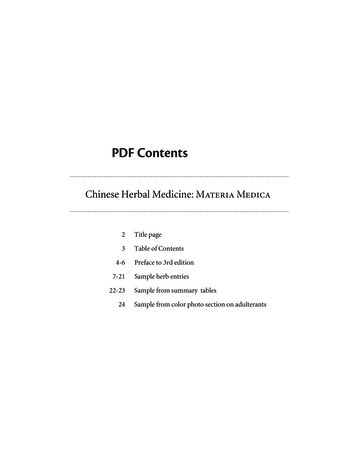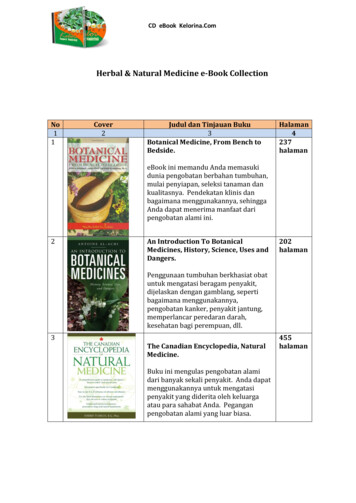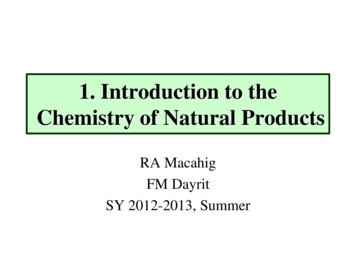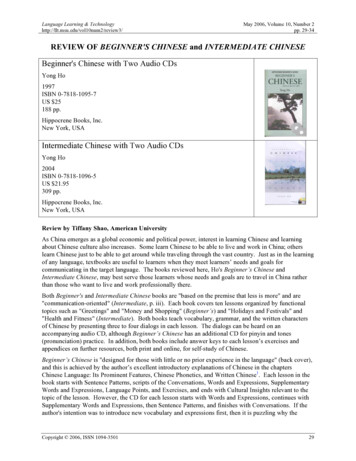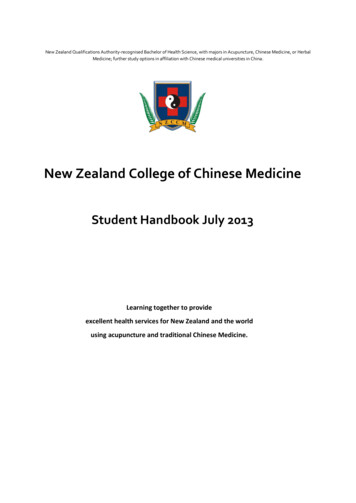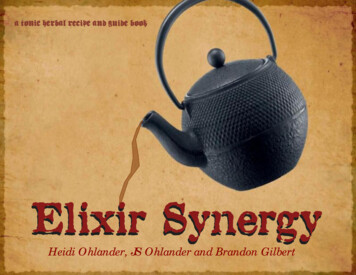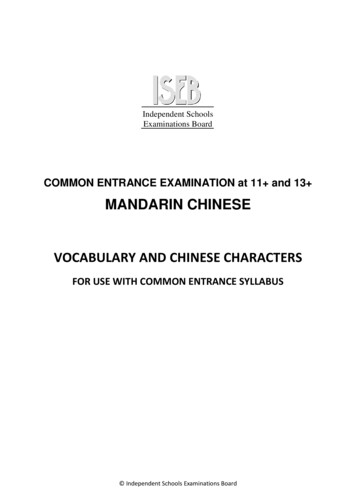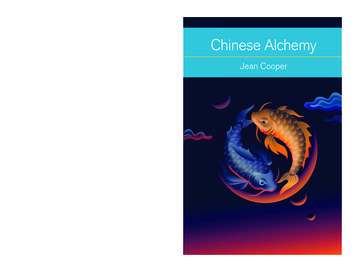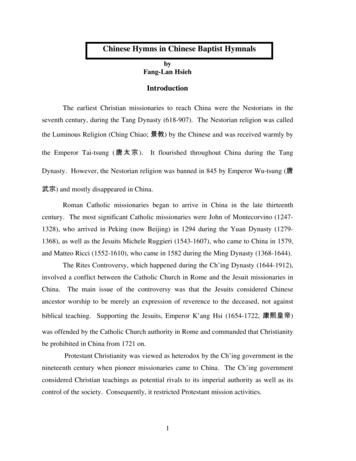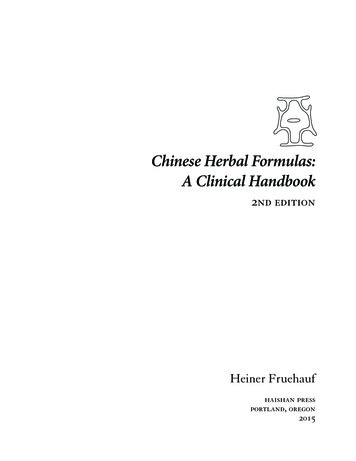
Transcription
Chinese Herbal Formulas:A Clinical Handbook2nd editionHeiner Fruehaufhaishan pressportland, oregon2015
3AcknowlegementsIntroductionOrganizational StructureHerbal Alchemy: The Basics ofChinese Herbal Formula ScienceClassical to Modern Dosage ConversionsTable of ContentsB79910141Cinnamon: Traditional Perspectives& FormulasCinnamon (Guizhi): Cinnamoni ramulusGuizhi TangGegen TangXiao Qinglong TangGuizhi Shaoyao Zhimu TangXiao Jianzhong TangFuling Guizhi Baizhu Gancao Tang(Ling Gui Zhu Gan Tang)Fuling Guizhi Gancao Dazao TangGuizhi Jia Longgu Muli TangDanggui Si Ni TangWuling SanGuizhi Fuling WanWumei Wan15151820212325262829303133342Aconite: Traditional Perspectives& FormulasAconite (Fuzi): Aconiti tuberSi Ni TangZhenwu TangWen Pi TangQianyang Dan3737444546473Bupleurum: Traditional Perspectives& FormulasBupleurum (Chaihu): Bupleuri radixXiao Chaihu TangChaihu Guizhi TangDa Chaihu TangSi Ni SanChaihu Jia Longgu Muli TangChaihu Guizhi Ganjiang TangXiaoyao SanLongdan Xiegan TangChai Ge Jieji TangChaihu Shugan San494951535456575960626466
Chinese Herbal Formulas: A Clinical Handbook (2nd Edition) · Heiner Fruehauf44Rhubarb: Traditional Perspectives& FormulasRhubarb (Dahuang): Rhei rhizomaXiao Chengqi TangDa Chengqi TangDahuang Mudanpi TangYinchenhao TangShaoyao Tang8676769707172745Coptis: Traditional Perspectives& FormulasCoptis (Huanglian): Coptidis rhizomaXie Xin TangGegen Huangqin Huanglian Tang(Gegen Qin Lian Tang)Huanglian Jiedu TangPuji Xiaodu YinTianma Gouteng YinLiang Ge San777779Pinellia: Traditional Perspectives& FormulasPinellia (Banxia): Pinelliae tuber105105Xuanfu Daizhe TangBanxia Xiexin TangBanxia Houpo TangWen Dan TangHuoxiang Zhengqi SanWu Ji SanSan Ren TangBanxia Baizhu Tianma TangSuzi Jiangqi TangDingchuan TangBaohe WanMaimendong 9Ginseng: Traditional Perspectives& FormulasGinseng (Renshen): Ginseng radix878710Lizhong Wan (Renshen Tang)Si Junzi TangShen Ling Baizhu SanGuipi TangShiquan Dabu Tang899091939567Astragalus: Traditional Perspectives& FormulasAstragalus (Huangqi): Astragali radixYupingfeng SanBuzhong Yiqi TangBuyang Huanwu Tang979798100102Evodia: Traditional Perspectives& FormulasEvodia (Wuzhuyu): Evodiae FructusWuzhuyu TangWenjing TangSishen WanTang-Kuei: Traditional Perspectives& FormulasTang-Kuei (Danggui): Angelicae radixSi Wu TangBa Zhen TangDanggui SanDanggui Shaoyao SanXuefu Zhuyu TangDuhuo Jisheng TangDanggui Jian Zhong TangXiaofeng SanBaosheng Wuyou 9
Table of Contents11Rehmannia: Traditional Perspectives& FormulasRehmannia (Dihuang): Rehmanniae radix[Jingui] Shenqi WanLiuwei Dihuang WanYiguan JianZhi Gancao TangTianwang Buxin DanYanghe TangBaihe Gujin TangYunü JianXijiao Dihuang Tang15115115415515715816016216316516612Forsythia: Traditional Perspectives& FormulasForysythia: Forsythiae FructusYinqiao SanSang Ju YinSuzi Lihou TangEphedra: Traditional PerspectivesHoelen/Poria: Traditional Perspectives& FormulasSuanzaoren TangAtractylodes: Traditional Perspectives16716716817017117317317517717814Gu: History, Clinical Perspectives& Representative FormulasDriving Out Demons & Snakes:Gu Syndrome, A Forgotten ClinicalApproach to Chronic ParasitismTreating Chronic Inflammatory Disease withChinese Herbs: An Interview on the PracticalApplication of Gu Syndrome19820821121315Mini Formulas to Tonify Yin(for formula modifcation)Shengmai SanBaihe Dihuang TangBaihe Zhimu TangShaoyao Gancao Tang2152152172182181613Other Formula Categories:Traditional Perspectives & FormulasLyme Disease: An In-Depth Interviewwith Heiner FruehaufSu He TangJiajian Su He TangQinghao Biejia Tang5181181190Mini Formulas that Transform Phlegm,Damp & Masses(for formula modifcation)Erzhi WanPingwei SanEr Chen TangGualou Xiebai Banxia TangWeijing TangDai Ge SanSanzi Yangqin TangZhi Zhu WanEr Miao SanIndex: EnglishIndex: Pinyin211211222224225227228228229230231234
9IntroductionBWe hope that this book, and its coming editions, will beof use to you as you seek to come into a deeper, more vitalrelationship with the study and practice of Chinese herbalmedicine. It has been specifically created as a clinicalhandbook for students and practitioners interested in alineage based practice of herbal medicine. As such, thisvolume has a different structure and different content thanmost formulas textbooks. This introduction will outlinethe basic philosophy that underlies the organization andcontent of the book, and review some basic details aboutthe science of Chinese herbal formula prescribing.Organizational StructureIf you leaf through this volume, or even just peruse theindex, you will notice that it is organized differently frommost formulas textbooks. The prescriptions are listed byherb families, instead of the more common method ofcategorizing according to the “eight strategies” (bafa).What is the advantage of discussing formulas accordingto single herb categories rather than the standard bafaapproach?Most Chinese herbal textbooks are structured inaccordance with the eight therapeutic strategies: sweating(han), vomiting (tu), purging (xie), harmonizing (he),warming (wen), clearing (qing), dissolving (xiao) andtonifying (bu). Memorizing herbs and formulas in groupsthat correspond with these eight methods is a simple wayto get a basic grasp of the herbs and their actions. WhenGuizhi Tang is memorized as a diaphoretic formula, forinstance, one quickly understands the most basic clinicalsituation in which this formula can be used.However, consider another possibility – the one thatguides the organization of this book. The principle ofthis text is to organize the herbs into “formula families”associated with the chief, or most representative, herb inthe formula. In this case, one’s knowledge of the formulaexists alongside one’s knowledge of the single herb withwhich it is associated. There are three main positivebenefits to learning formulas according to herb families –I will illustrate each with an example.1) Focusing on single herbs helps students gain deeper,and more accurate understanding of associated formulas.Consider the cinnamon herb family. In a standardtextbook, cinnamon remedies are found in virtuallyevery category of formulas. As a student, it is extremelyimportant to understand the multidimensional quality ofthis herb - it has the potential to unfold profound benefitsfor every organ system at every layer of the body. However,if two important cinnamon formulas are presented invery different categories, the standard bafa structure can
Introductionfang as square. In the cosmic map of China’s most ancientShang dynasty, the cosmic map of Earth is portrayed infive quadrants: top, bottom, left, right and center. TheChinese term for square is thus a synonym for the cardinaldirections: north, south, east, west and center.Ancient medical masters thus viewed a formula as a tightlyorganized collection of herbs coming together to producethe power of a specific direction - a formula emulating theenergetic quality of South, for instance. This can be usedto enhance a balanced “Southern” state in a patient: warmand luscious, but not too hot and damp.In a clinical context, it can be very difficult to siftthrough the vast body of formula knowledge and arriveat the appropriate prescription for a patient. Novicepractitioners often find themselves paralyzed because themany thousands of possible formula combinations, withtheir attendant actions and indications, represent too largea field of prospects. The meanings of fang, discussed here,help us to understand that we needn’t become paralyzedby the overwhelming amount of details and choices. Themost important thing to do is to get in the right ballpark, orin other words, to match the general direction the patientrequires. The two boats, moving in the correct directionand working together closely, will get the recovery processon track.This does not mean, of course, that very minute coursecorrections are not necessary. They are - and sometimes,minor adjustments in formulas can make all thedifference. Some types of common formula modificationswill be discussed at the end of this chapter, and againat the end of the book. The most important thing for aformula student to remember, however, is to focus on thedirectionality of the formula and to be certain that theprescription is situated in the right ballpark.BOrder in Herbal Formulas and the OrganizationalPrinciple of Jun, Chen, Zuo, ShiClassical formulas exhibit an inherent structure thatis dictated by their intended effects. While many of usmay have difficulty understanding this structure at first,with study and practice it will become evident as the11organizational backbone of ancient formula science.One of the easiest ways to think about the structure ofa formula, after all, is by determining the hierarchy ofherbal ingredients within it.Ancient masters of alchemy compared the structure of aformula to the organization of an administrative entity.How is a formula like a government?» Jun 君: EmperorThe emperor is irreplaceable and the “head of state” ofa formula. If the emperor in a formula is changed, itbecomes a different formula altogether. The emperordetermines the entire direction of the formula and nestsit in one formula family or another. All of the othermembers of the formula are working from the basicfunctional direction set by the emperor herb. In learningformulas, fully comprehending the nature of the emperorwill take you a long way in understanding the formula.The chapters of this book are, in many cases, organizedby emperor herb.» Chen 臣: MinisterThe minister is second in power behind the emperor. Whileyou could, in theory, change the minister of a formula andstill retain most of the important characteristics of thatformula, the full depth of the power of a Classical formulainvolves the function of all of the positions - particularly theminister. Minister herbs are often used to complement theemperor in the major function of the formula. However,they may be used to temper the emperor, making theformula more tolerable. They might also bring anothermajor function (especially secondary symptom relief) intothe formula, expanding the scope of the formula.» Zuo 佐: AssistantAssistant herbs are narrower in scope than either emperoror minister. An assistant may, like the minister, be similarin character to the emperor, thus increasing the strengthof its major functions. Sometimes an assistant may addressa secondary or tertiary complaint not already addressed bythe emperor and minister. The assistant can also restrainthe intensity of both emperor and minister, lesseningside effects and improving patient outcomes. While theassistant herbs may seem to be less potent members of aformula, it is important not to minimize their role. Theemperor and minister herbs alone, in most cases, do notcreate the kind of elegant formulas that characterize thehighest practice of Chinese medicine. Assistants help theformulas to have a wider scope and more potent effect,while avoiding alchemical instability and uncomfortableside effects.
151Cinnamon: Traditional Perspectives& Formulas桂枝Cinnamon Twig (Guizhi):Ramulus cinnamomi1) Cinnamon twig primarily enters the muscle layer atthe surface of the body. At the same time, it enters theheart and liver channels. It is the branch of the cassiatree which also yields cinnamon bark. Cinnamon twig islight, its nourishing essence is pungent, and its color is red(therefore its affinity to the heart).The action of cinnamon twig is rising without descending.Therefore, it can also enter the lung and facilitateuninhibited movement of qi, and enter the bladderchannel and stimulate water metabolism. In a horizontaldirection, it enters the upper extremities, harmonizes yingand wei, and thus treats pain in the arms and sides of thechest.Cinnamon twig controls restless sweating, dispels wind,and disperses external pathogens. It is the primary herbto relieve the muscles. Therefore, the books all say thatcinnamon twig can induce sweat if there is none; and thatit can astringe sweat if there is too much of it. Actually,the type of sweat that can be induced or controlled bycinnamon is caused by wei excess and ying deficiency,refering to a situation where the yin is being advancedupon by yang. Therefore, cinnamon can be used toregulate the ying. If the ying is regulated, then the weiwill become harmonious by itself. Since now there will beno place to go to for the wind pathogen, it will be relievedvia the sweat. This action is quite different from thatof ephedra, which can directly open the pores and thusinduce sweat.The type of sweat that can be astringed by cinnamon iscaused by wind injury to the wei layer, which in turn
16Chinese Herbal Formulas: A Clinical Handbook (2nd Edition) · Heiner Fruehaufcannot attend to (holding) the ying (in place); the yingqi is weak, and the fluids and humors thus not securedproperly; therefore, the patient experiences symptoms ofsweating, fever, and aversion to wind. This condition isbest treated with Cinnamon Combination (Guizhi Tang),since this remedy contains peony to enter the ying andastringe the yin inside, and cinnamon to enter the wei andeliminate the pathogens outside. In this way, the sweat willstop naturally. This does not mean that cinnamon closesthe sweat pores directly. In other words, if you just saythat cinnamon induces sweat and controls sweat withoutunderstanding why and under what conditions, you willmiss the meaning of cinnamon by far.[from Huang Gongxiu, Bencao qiuzhen (Exploring theTrue Meaning of the Materia Medica), 1769]B2) The nourishing essence of cinnamon is pungent andslightly sweet, and its functional nature is warming.It opens up the energy pathways, raises the ancestral qiupwards, descends counterflow of qi (such as flushing up,or liver qi flushing up), and disperses pernicious qi (as inwind cold situations).Zhang Zhongjing’s Atractylodes and Hoelen Combination(Ling Gui Zhu Gan Tang) employs cinnamon to treatshortness of breath, utilizing the herb’s ascendingproperties. His Cinnamon Plus Cinnamon Combination(Guizhi Jia Gui Tang) employs cinnamon to treatrunning piglet syndrome, utilizing the herb’s descendingproperties. And his Ma-huang Combination (MahuangTang), Cinnamon Combination (Guizhi Tang), andMinor Blue Dragon Combination (Xiao Qinglong Tang)all use cinnamon to treat external cold affliction, utilizingthe herb’s dispersing properties.Defining the properties of cinnamon twig, Shen Nong’sHerbal Classic states at the very beginning that cinnamontreats coughing and upward counterflow of qi, a factthat seems to underscore once more that it is really thedescending quality of cinnamon that is its specialty.However, rarely do we find that one of the other materiamedicas emphasizes this descending quality. This cameto foster a use of cinnamon which neglected its mostoutstanding feature.Another example illustrating this point is the fact that inthe context of Minor Blue Dragon Combination, ephedraand cinnamon are used side by side. For patients sufferingfrom asthmatic breathing, the original source suggeststo remove ephedra and add apricot seed, but not toremove cinnamon. The formula’s author had apparentlyconsidered the Herbal Classic line that cinnamon treats“spitting breath,” an ancient term for asthma, and thoughtthat by removing cinnamon, the formula would not beable to treat this problem anymore. Since many physiciansnowadays fail to read the Herbal Classic, they only knowthat ephedra can drain the lung and calm asthma, but areunaware of the fact that cinnamon can descend qi andcalm asthma.The cassia flowers blossom in mid-autumn, demonstratingthat the plant’s functional nature becomes activatedas soon as it receives metal qi. At the same time, thenourishing essence of cinnamon is pungent, anotherindication that links it to metal. Cinnamon, therefore, isable to keep the upflaring tendency of liver wood in check.Also, the branches of the cassia tree grow in the form ofa deer antler (tree forms are generally differentiated intodeer antler form and crab claw form), going straight upwithout bending. Therefore, cinnamon twigs can regulatethe straightforward quality of the liver, and moderate itstendency to become bogged down and depressed.Since its essence is sweet, it is also a good herb to harmonizethe spleen and the stomach, causing collapsed spleen qi torise and rebellious stomach qi to descend. Once the spleenand the stomach are properly regulated and in harmony,accumulations of phlegm or stagnating food will naturallydisappear. Its circulating powers can also entice the force ofthe triple warmer to enter the bladder and thus disinhibiturination (do not use cinnamon, however, if there isinhibited urination that is due to heat; you may, as somedoctors do, use a little bit of cinnamon in combinationwith cooling herbs, in order to entice the herbal effectsinto the bladder). The only situation where cinnamonshould be thoroughly avoided is heat in the upper burner,or patients who regularly suffer from bleeding disorders.I should emphasize that cinnamon twig is not a sweatinducing herb, just as it is not a sweat astringing herb. Itscirculating and surface dispersing force spirals in betweenthe surface and the interior: it can thus harmonize yingand wei, warm the flesh and the muscles, and invigoratemovement within the blood vessels. It is due to theseactions, then, that wind cold resolves and surface paralysisopens up.The essence of cinnamon is both pungent and sweet: thepungent flavor disperses, the sweet flavor tonifies. Thefunction of cinnamon, therefore, is somewhere in betweendispersing and tonifying. Let’s say that somebody wants totake Cinnamon Combination for the purpose of inducingsweat, the source book suggests that s/he must take somehot porridge along with it. This addendum illustrates thatCinnamon Combination by itself does not have a strongsweat inducing effect. On the other hand, if somebody
Cinnamon: Traditional Perspectives & Formulas21Modern Modifications: For weak constitution, atypically deep pulse, cold/flu accompanied by sweat, remove or decreaseMahuang (this will produce Guizhi Jia Gegen Tang); for nausea, add Banxia; for recurrent surface tension, add XiaoChaihu Tang (this will produce Chaihu Guizhi Tang with Mahuang and Gegen added); for sinus congestion, may addXinyinhua and Chuanxiong; for sinus congestion with secretion of yellow phlegm, heavily add Gualou; for early stageof rheumatoid arthritis, add Yiyiren, Danggui, Baishao, and Baizhu (this will produce Yiyiren Tang with (Sheng) Jiang,Dazao, and Gegen added); for back and leg pain, add Duhuo and (Sheng) Dihuang.小青龍湯Xiao Qinglong TangMinor Blue-Green Dragon DecoctionSource: On Cold Damage (Shanghan lun)Xiao Qinglong Tang first appeared in the classic formula compendium, Shanghan lun. It is a famous modification of bothGuizhi Tang and Mahuang Tang, specifically designed for lung congestion with clear phlegm in the yang deficientpatient. The Blue-Green Dragon is a stellar confirmation in the eastern sky, which is associated with spring and wind.Spring is a period of frequent wind afflictions (such as colds and allergies). Also, it is the time when a developing yang(warmth, light) gains superiority over a gradually diminishing yin (cold, darkness). If the human body cannot hold stepwith this decisive move in nature, symptoms of pathological yin (phlegm) will appear and cause chills, water stagnation,and coughing. The dragon, moreover, is the symbolic governor of water. Nature’s water metabolism has always been thekey to health and prosperity in agriculture based societies. According to traditional lore, the large dragon can dance in theclouds and entice rain if there is not enough water, and the small dragon can submerge itself in the waves if there is toomuch water. Major Blue Dragon Tang, therefore, is mostly used to induce sweat (“not enough water”) in patients with astrong constitution, while Xiao Qinglong Tang is generally prescribed to remove stagnating fluids and phlegm (“too muchwater”) in patients with a weak constitution. In modern Japan, this formula has become one of the prime remedies totreat lung problems in children as well as allergic sinus problems characterized by profuse nasal discharge. In the originalShanghan lun version, no prominent use of Banxia is recorded. In modern clinical practice, a daily dose usually consists of10g of each of the herbs, but Wuweizi and Xixin are often used in more moderate amounts (3-6g).Category: Formulas that release exterior coldTherapeutic Principles: Relieve the surface and disperse cold, warm the lung and transform phlegm, control coughing,asthma, and allergic sinus reactionsTypical Symptoms: Chills, possibly accompanied by fever, but without sweat; profuse production of clear, runny, orsometimes foamy phlegm by the lungs and/or sinuses; runny eyes; cold feeling in upper back; coughing and/or asthmaticwheezing; gurgling sounds or feeling of stagnation in epigastric region; dry mouth without desire to drink; nausea; stuffychest; heavy and painful feeling in body, puffy face and extremities; decreased urinationPulse: Floating and tight, or floating and weak, or floating and rapidTongue: Pale, with white and slippery coatingWestern Indications: Colds, flus, upper respiratory tract infections (including acute bronchitis or acute flare-up of chronicbronchitis, pneumonia), bronchial asthma, allergic asthma, allergic rhinitis, hypertrophic rhinitis, whooping cough;catarrhal ophtalmia, dacryocystitis; pleurisy, hydrothorax; high gastric acidity (only if accompanied by feeling of epigastricstagnation); eczema, blisters (only if lots of clear secretions); arthritis, acute and chronic nephritis (only if puffy face andextremities, decreased urination)
Chinese Herbal Formulas: A Clinical Handbook (2nd Edition) · Heiner Fruehauf22Herbs and Actions:ClassicalDosageModernDosage3 liang6-9 gMahuangEphedraEphedrae HerbaPerfuse lung qi, calm asthmatic breathing, andopen up the sinuses; expel surface cold and inducesweating3 liang9-12 gGuizhiCinnamon twigCinnamomi RamulusExpel surface cold and induce sweating3 liang9-12 gShaoyaoPeony rootPaeoniae RadixNourish yin and blood and astringe body fluids tobalance the strongly diaphoretic action of Mahuangand Guizhi3 liang9-12 g(Gan) JiangDried gingerZingiberis RhizomaWarm the lung and disperse stagnating fluid3 liang6-9 gXixinAsarumAsari HerbaWarm the lung and disperse stagnating fluidNormalize mucous secretions, and protectivelymoisten and astringe the lung to balance thestrongly drying and dispersing action of Xixin andShengjiangPinyinCommon NameLatin NameAction(s)0.5 sheng6-9 gWuweiziSchizandraSchisandrae Fructus0.5 sheng9-12 gBanxiaPinelliaPinelliae ternataeRhizomaEnhance the anti-phlegm effect and counteractnausea(Zhi) GancaoHoney-fried licoriceGlycyrrhizae RadixHarmonize yin (nourishing, moistening,astringing) and yang (warming, drying, dispersing)actions of herbs; moderate diaphoretic anddispersing effect of the formula0.5 sheng3-6 gTraditional Modifications: (Shanghan lun 40) Thirst: minus Banxia, add Gualougen (Tianhuafen); Mild diarrhea: minus Mahuang, add Raohua (Wikstroemia canescens, dry-fried); Dysphagia: minus Mahuang, add (Zhi) Fuzi; inhibited urination and lower abdominal pain: minus Mahuang, addFuling; Panting: minus Mahuang, add Xingren.Typical Modifications: for restlessness, thirst with desire to drink, yellow tongue coat, or other symptoms of secondaryheat, add Shigao (this will produce Xiao Qinglong Jia Shigao Tang); for severe coughing, add Xingren; for nausea,combine with Er Chen Tang; for edema, add Fuling; for chronic bronchitis without surface symptoms, remove Mahuang,Guizhi, Banxia, and Baishao, add Fuling (this will produce Ling Gan Wuwei Jiang Xin Tang; if pronounced coughingand phlegm, do not remove Banxia, further add Xingren); for chronic asthma, add Taizishen and Zisuzi; for whoopingcough, add Nan Shashen, Wumei, Tianhuafen, and Fuling.
Chinese Herbal Formulas: A Clinical Handbook (2nd Edition) · Heiner Fruehauf44四逆湯Si Ni TangFrigid Extremities DecoctionSource: On Cold Damage (Shanghan lun)Si Ni Tang is the representative remedy for Shaoyin disorders in the classical formula manual, Shanghan lun. Traditionally,it is known as a remedy that is used exclusively for the recapturing of the escaping life force in emergency situations,such as elderly patients suffering from a heart attack. Due to the extreme toxicity of unprocessed aconite (Fuzi), it wouldbe important to boil the Fuzi thoroughly with the Ganjiang and Gancao (heat application greatly diminishes the toxinaconitine in Fuzi) if used according to original specifications. More important for using this remedy in the age of modernemergency medicine is to learn from the way how the Fire Spirit School of Sichuan herbalism has been using this remedyfor the last 150 years. Zheng Qin’an, the Qing dynasty physician who is regarded as the founder of the Huoshen lineage,based all remedies for chronic patients requiring warming and at the same time consolidating action on the therapeuticprinciple exemplified by Si Ni Tang, labeling it Si Ni Fa—the Si Ni Tang Method.Category: Formulas that rescue devastated yangTherapeutic Principles: Rescue escaping yangTypical Symptoms: All shaoyin symptoms; fatigue, cold hands and feet, blue lips; loss of consciousness, or cloudedconsciousnessTongue: Fat and pale, with tooth marksPulse: Weak and slow, or feeble and rapidWestern Indications: Heart attack and other life-threatening diseases (acute usage); obvious immune deficiencies in theelderly (long-term usage, especially in the Fire Spirit School of Chinese herbalism)Herbs and Actions:ClassicalDosageModernDosage1 piece10-15 g(Sheng) FuziFresh aconiteAconiti Radix lateralisrecensDraw escaping yang qi back into the lowerdantian; warm spleen and kidney yang1.5 liang6-9 g(Gan) JiangDried gingerZingiberis RhizomaWarm spleen and kidney yang; moderates thepotential toxicity of Fuzi2 liang10-15 g(Zhi) GancaoHoney-fried licoriceGlycyrrhizae RadixModerate potential toxicity of FuziPinyinCommon NameLatin NameAction(s)Traditional Modifications: (Shanghan lun 317) Red Facial Complexion: add Congbai; Abdominal Pain: add Shaoyao; Retching: add (Sheng) Jiang; Sore Throat: add Jiegeng; Diarrhea Ceases but Pulse does not Move Outward: add Renshen.Modern Modifications: This is a formula that is not often used by modern TCM practitioners, especially as prescribedin the original text (which according to most experts specifies raw, unprocessed Fuzi). For the The Fire Spirit School ofSichuan herbalism (Huoshen Pai), however, it is the most important base formula for the treatment of chronic diseases,and the base for many more complex remedies. This remedy generally calls for 18-120 g of Fuzi, albeit in processed form.
15111Rehmannia: Traditional Perspectives& Formulas地黃Rehmannia (Dihuang): Rehmanniae radix1) Dry rehmannia–that is the dried, unprocessed freshroot–primarily enters the kidney, and it also enters theheart and the spleen. Its nutritive essence is bitter andsweet, and its functional nature is yin and cold. If weconsult the source book of Dr. Zhang Lu from Changzhou(Comprehensive Medicine According to Master Zhang, ZhangShi Yi Tong), we read the following:“At its very heart rehmannia is red and thus enters theheart; inside it is yellow and thus enters the spleen; its skinis black and thus enters the kidney. The nutritive essenceof rehmannia is strong, while its functional qi is weak.Internally, it mostly cools the blood and enriches yin,while externally it moistens the skin and promotes a glossyappearance. The use of rehmannia is indicated in situationswhen the patient is deficient and exhibits signs of heat(if there are no heat signs, cooked rehmannia should beused). Just as Dai Yuanli once stated: ‘In situations wherethe yin is feeble and the yang exuberant, the ministerialfire is generally flaring beyond its boundaries and invadesyin territory. There, it keeps steaming the yin, causing asymptom complex of yin deficiency and fire flare-up. Forthis type of disorder, one should use rehmannia to enrichthe yin and control upflaring yang.’In combination with ginseng, hoelen, and honey,rehmannia produces Jade Gelatin (Qiongyu Gao), aremedy that treats tubercular coughing accompanied byhacking blood (thus primarily tonifying the lung yin). Incombination with ophiopogon, cooked rehmannia, andginseng, raw rehmannia produces Stabilize the Root Pill(Guben Wan), a remedy that treats conditions of dryedup jing and blood in the elderly (while at the same timestabilizing the kidney root). If we add lycium fruit gelatin
152Chinese Herbal Formulas: A Clinical Handbook (2nd Edition) · Heiner Fruehaufto this prescription, it is called Gather Spirit Gelatin(Jiling Gao), a remedy that treats deficiency emaciationaccompanied by coughing and chronic fatigue (stabilizingall organ networks simultaneously).In simplified terms, the general principle for the use ofrehmannia is the following: males tend to be yin deficient,and thus should take cooked rehmannia; females tendto easily develop conditions of blood heat, and thusshould take raw rehmannia. Never forget, however, todifferentiate this usage according to the constitution of theindividual patient!Yu Bo once said: ‘Raw rehmannia cools the blood, but inpatients with weak stomach qi it may cause symptoms ofpoor appetite. Cooked rehmannia tonifies the blood, butin patients with lots of phlegm-rheum it may gum up thediaphragm.’ Although these two potential complicationsare actually very, very important, contemporary doctorsrarely bother to heed this principle in clinical practice.Some people say that if raw rehmannia is fried in alcohol,then its appetite inhibiting affect will be neutralized, orthat if cooked rehmannia is processed with ginger, thenit will not gum up the diaphragm. But no matter what,w
lineage based practice of herbal medicine. As such, this volume has a different structure and different content than most formulas textbooks. This introduction will outline the basic philosophy that underlies the organization and content of the book, and review some basic details about the scienc
